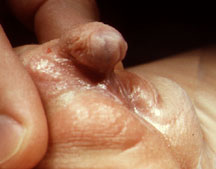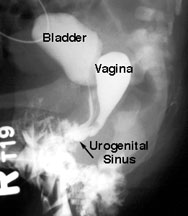If abnormalities of cell division occur, a fetus with mosaicism may result. The baby may have both cells with 46 XY chromosomes and cells with 46 XX chromosomes. This condition has been called hermaphroditism (after the greek god Hermes and goddes Aphrodite) and it is one of many causes of intersex. Because both male (46-XY) and female (46-XX) cells exist within the same fetus, both male and female structures develop. Typically, the penis is not completely virilized (hypospadias). One or both testes may not be palpable or they may be palpable, but undescended. Whenever you see an infant with both hypospadias and an undescended testis (cryptorchidism), you must consider the possibility of intersex.
Internally, Müllerian structures develop (uterus, oviducts, vagina). Gonadal tissue of both genders is present in various patterns: a testis on one side and an ovary on the other, a testis on one side and an ovo-testis (gonad containing both ovary and testis) on the other, or an ovary on one side and an ovo-testis on the other.

Whenever you suspect intersex you should confirm the diagnosis by ordering
a karyotype. In addition, the child should have an abdominal ultrasound
to look for Müllerian structures and a voiding cystourethrogram (VCUG)
to evaluate the urethra.
This VCUG shows that what appeared externally to be a urethra on the penis of a baby with hypospadias is actually a persistent urogenital sinus (the undivided chamber consisting of the developing urethra and vagina).
